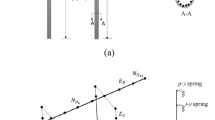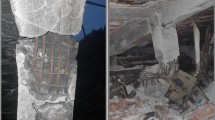Abstract
Many bridges located in seismic hazard regions suffer from serious foundation exposure caused by riverbed scour. Loss of surrounding soil significantly reduces the lateral strength of pile foundations. When the scour depth exceeds a critical level, the strength of the foundation is insufficient to withstand the imposed seismic demand, which induces the potential for unacceptable damage to the piles during an earthquake. This paper presents an analytical approach to assess the earthquake damage potential of bridges with foundation exposure and identify the critical scour depth that causes the seismic performance of a bridge to differ from the original design. The approach employs the well-accepted response spectrum analysis method to determine the maximum seismic response of a bridge. The damage potential of a bridge is assessed by comparing the imposed seismic demand with the strengths of the column and the foundation. The versatility of the analytical approach is illustrated with a numerical example and verified by the nonlinear finite element analysis. The analytical approach is also demonstrated to successfully determine the critical scour depth. Results highlight that relatively shallow scour depths can cause foundation damage during an earthquake, even for bridges designed to provide satisfactory seismic performance.
Similar content being viewed by others
References
Alipour A and Shafei B (2012), “Performance Assessment of Highway Bridges under Earthquake and Scour Effects,” Proceedings of the 15th World Conference on Earthquake Engineering, Lisbon, Portugal, September 24-28.
Alipour A, Shafei B and Shinozuka M (2013), “Reliability-based Calibration of Load and Resistance Factors for Design of RC Bridges under Multiple Extreme Events: Scour and Earthquake,” ASCE Journal of Bridge Engineering, 18(5): 362–371.
American Petroleum Institute (API) (1987), API Recommended Practice for Planning Designing, and Constructing Fixed Offshore Platforms, API Recommended Practice 2A (PR2A), Seventeenth Edition, Washington D.C.
Applied Technology Council (ATC) (1996), Improved Seismic Design Criteria for California Bridges: Provisional Recommendations, ATC-32, Redwood City, California, 102–122.
Banerjee S and Prasad GG (2013), “Seismic Risk Assessment of Reinforced Concrete Bridges in Flood-Prone Regions,” Structure and Infrastructure Engineering, 9(9): 952–968.
Boulanger RW, Curras CJ, Kutter BL, Wilson DW, and Abghari A (1999), “Seismic Soil-pile-structure Interaction Experiments and Analysis,” Journal of Geotechnical and Geoenvironmental Engineering, ASCE, 125(9): 750–759.
California Department of Transportation (Caltrans) (2011), California Amendments to AASHTO LRFD Bridge Design Specifications, Fourth Edition, Sacramento, California, 10–84A.
Chopra AK (2011), Dynamics of Structures: Theory and Applications to Earthquake Engineering, Pearson Prentice Hall, Upper Saddle River, New Jersey.
Davisson MT (1970), “Lateral Load Capacity of Piles,” Highway Research Record, 333: 104–112.
Dilley M, Chen RS, Deichmann U, Lerner-Lam AL and Arnold M (2005), Natural Disaster Hotspots: A Global Risk Analysis, The World Bank, Washington, D.C., 1–10.
Hwang JS, Sheng LH and Gates JH (1994), “Practical Analysis of Bridges on Isolation Bearings with Bi-linear Hysteresis Characteristics,” Earthquake Spectra, 10(4): 705–727.
Kent DC and Park R (1971), “Flexural Members with Confined Concrete,” Journal of the Structure Division, ASCE 97(ST7): 1964–1990.
Khan Z and Amanat K (2014), “Riverbed Scouring Effect in Bridge Pile Foundation during Earthquake,” Advances in Soil Dynamics and Foundation Engineering, 343–352.
Lundgreen CC (2010), “Damping Ratio for Laterally Loaded Pile Group in Fine Grained Soils and Improved Soils,” Master Thesis, Brigham Young University.
Mander JB, Priestley MJN, and Park R (1988), “Theoretical Stress-strain Model for Confined Concrete,” Journal of Structural Engineering, ASCE 114(8): 1804–1826.
Mazzoni S, McKenna F, Scott MH and Fenves GL et al. (2009), Open System for Earthquake Engineering Simulation (OpenSees), Pacific Earthquake Engineering Research Center, University of California, Berkeley, CA.
Menegotto M and Pinto PE (1973), “Method of Analysis for Cyclically Loaded Reinforced Concrete Plane Frames including Changes in Geometry and Non-elastic Behavior of Elements under Combined Normal Force and Bending,” IABSE Symposium on Resistance and Ultimate Deformability of Structures Acted on by Welldefined Repeated Loads, Final Report, Lisbon.
Ministry of Transportation and Communications (MOTC) (2008), Seismic Design Provisions and Commentary for Highway Bridges, Chinese Taipei, 71–76.
National Earthquake Hazards Reduction Program (NEHRP) (2003), NEHRP Recommended Provisions and Commentary for Seismic Regulations for New Buildings and Other Structures, FEMA 450, Washington, D.C.
National Earthquake Hazards Reduction Program (NEHRP) (2009), NEHRP Recommended Seismic Provisions for New Buildings and Other Structures, FEMA P-750, Washington, D.C.
Paulay T and Priestley MJN (1992), Seismic Design of Reinforced Concrete and Masonry Buildings, Wiley-Interscience, New York.
Prasad GG and Banerjee S (2013), “The Impact of Flood- Induced Scour on Seismic Fragility Characteristics of Bridges,” Journal of Earthquake Engineering, 17(9): 803–828.
Prakash S and Sharma HD (1990), Pile Foundations in Engineering Practice, Wiley-Interscience, New York.
Priestley MJN, Seible F and Calvi GM (1996), Seismic Design and Retrofit of Bridges, Wiley-Interscience, New York.
Priestley MJN, Calvi GM and Kowalsky MJ (2007), Displacement-based Seismic Design of Structures, IUSS Press, Pavia, Italy.
Scott BD, Park R and Priestley MJN (1982), “Stressstrain Behavior of Concrete Confined by Overlapping Hoops at Low and High Strain Rates,” ACI Journal, 79: 13–27.
Song ST and Chai YH (2008), “Performance Assessment of Multi-column Bents with Extended Pile-Shafts under Lateral Earthquake Loads,” The IES Journal A: Civil & Structural Engineering, 1(1): 39–54.
Wang ZG, Song W and Li TT (2012), “Combined Fragility Surface Analysis of Earthquake and Scour Hazards for Bridge,” Proceedings of the 15th World conference on Earthquake Engineering, Lisbon, Portugal, September 24-28.
Yuan YC, Lai W, Wang JJ and Hu SD (2005), “The Effects of Hydrodynamic Damping on Seismic Response of Bridge Plies,” World Earthquake Engineering, 21(4): 88–94. (in Chinese)
Yang Z, Lu J and Elgamal A (2008), OpenSees Soil Models and Solid-fluid Fully Coupled Elements, User’s Manual, Ver. 1.0, University of California, San Diego.
Author information
Authors and Affiliations
Corresponding author
Additional information
Supported by: Taiwan Science Council under Grant No. 100- 2625-M-005-002
Rights and permissions
About this article
Cite this article
Song, ST., Wang, CY. & Huang, WH. Earthquake damage potential and critical scour depth of bridges exposed to flood and seismic hazards under lateral seismic loads. Earthq. Eng. Eng. Vib. 14, 579–594 (2015). https://doi.org/10.1007/s11803-015-0047-9
Received:
Accepted:
Published:
Issue Date:
DOI: https://doi.org/10.1007/s11803-015-0047-9




